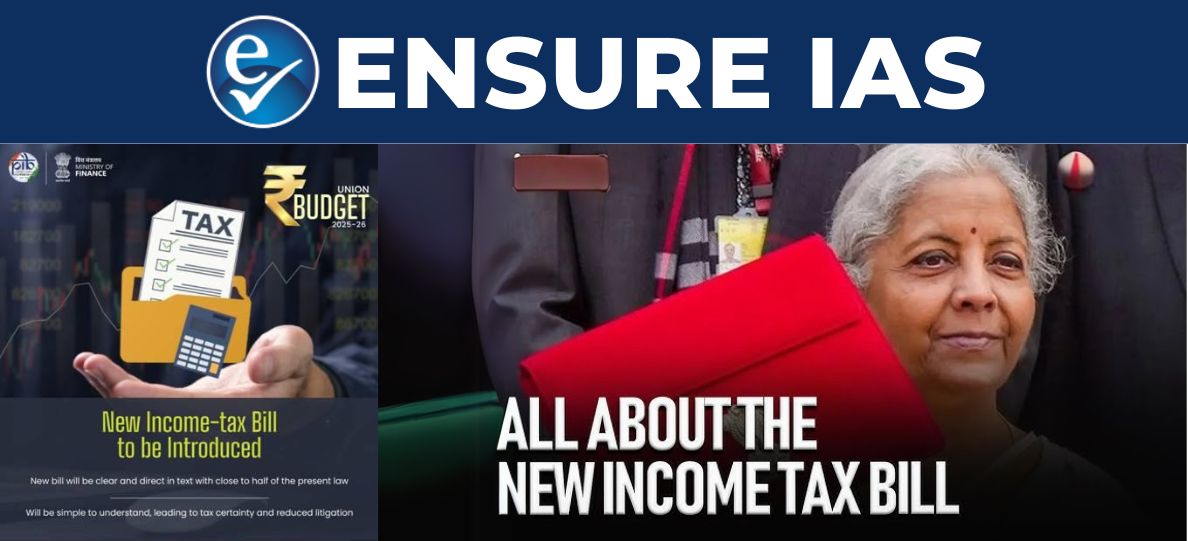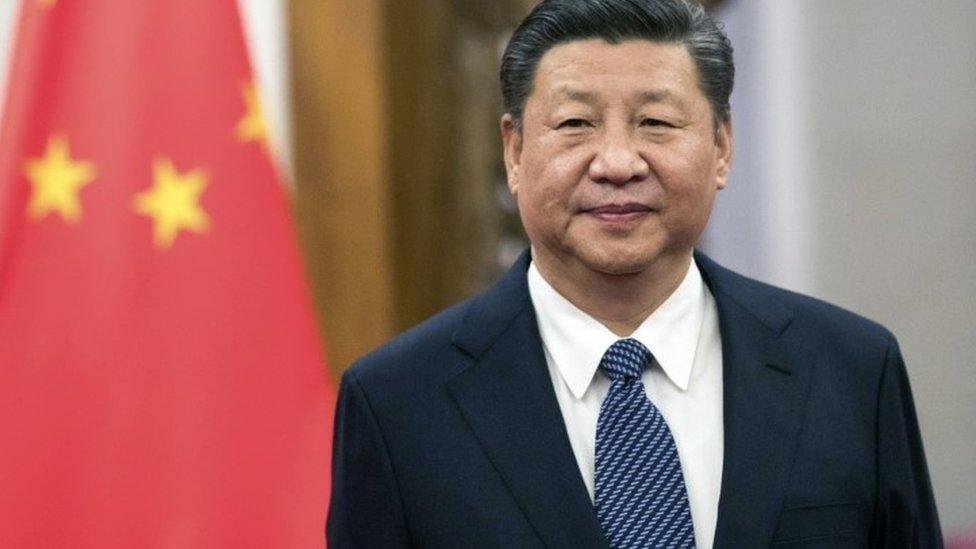- Courses
- GS Full Course 1 Year
- GS Full Course 2 Year
- GS Full Course 3 Year
- GS Full Course Till Selection
- Answer Alpha: Mains 2025 Mentorship
- MEP (Mains Enrichment Programme) Data, Facts
- Essay Target – 150+ Marks
- Online Program
- GS Recorded Course
- Polity
- Geography
- Economy
- Ancient, Medieval and Art & Culture AMAC
- Modern India, Post Independence & World History
- Environment
- Governance
- Science & Technology
- International Relations and Internal Security
- Disaster Management
- Ethics
- NCERT Current Affairs
- Indian Society and Social Issue
- NCERT- Science and Technology
- NCERT - Geography
- NCERT - Ancient History
- NCERT- World History
- NCERT Modern History
- CSAT
- 5 LAYERED ARJUNA Mentorship
- Public Administration Optional
- ABOUT US
- OUR TOPPERS
- TEST SERIES
- FREE STUDY MATERIAL
- VIDEOS
- CONTACT US
What’s new in the Income Tax Bill, 2025
What’s new in the Income Tax Bill, 2025

- In February 2025, The Income Tax Bill, 2025, was introduced in the Lok Sabha with the primary goal of simplifying and modernizing India's income tax framework.
- This bill seeks to create a clear, simpler, and streamlined legal structure to replace the existing Income Tax Act of 1961.
- If passed, the new law is expected to come into effect on April 1, 2026.
Key Features of the Income Tax Bill, 2025
1. Tax Year Concept:
- The Bill replaces the concept of "Assessment Year (AY)" with "Tax Year".
- This change aligns income tax assessments directly with the financial year (April 1 to March 31), removing confusion about previous and assessment years.
- Businesses and newly set-up professions will be taxed from their inception date, making it more business-friendly.
- Example: In the old system, if you earned money between April 2024 and March 2025, your taxes would be calculated in the year after, i.e., 2025-2026. With the new system, your tax will be calculated for the same year you earned it. So, if you earned money in 2024-2025, it will be assessed in the same period, 2024-2025.
2. Virtual Digital Assets (Cryptocurrency) as Property:
- The Bill recognizes virtual digital assets like cryptocurrencies as "capital assets," placing them under the same category as physical assets such as land, building, or jewelry. This builds on the Finance Bill, 2025, clarifying taxability of digital assets.
- Despite this clarification, the scope of "virtual digital assets" remains unchanged in terms of its definition under the Bill.
- Virtual digital assets (VDAs) are digital representations of value that can be traded, transferred, or used for payment. They include cryptocurrencies like Bitcoin and Ethereum, as well as non-fungible tokens (NFTs).
- Example: Let's say you buy a cryptocurrency in 2024 for ₹50,000 and sell it in 2025 for ₹70,000. The ₹20,000 profit is treated as a "capital gain" and is taxed the same way as if you sold a piece of land for a profit. This is a big change because before, it wasn't clear how cryptocurrencies would be taxed.
3. Dispute Resolution Panel (DRP):
- The Bill improves the dispute resolution mechanism by offering more transparency. It details the points of determination, decision, and reasoning behind the DRP's directions, unlike the earlier version which lacked clarity.
- Example: If the tax department says you owe ₹50,000 more in taxes and you disagree, you can go to the DRP. Under the new law, the DRP will give a clear explanation of how they made their decision, so you understand the reasoning behind it. In the past, it wasn’t always clear why they decided what they did.
4, Capital Gains and Exemptions:
- The Bill removes outdated provisions like Section 54E, which provided exemptions for capital gains on the transfer of assets before April 1992.
- Redundant exemptions and deductions, including outdated rules for salary-related benefits, have been removed or consolidated for better clarity.
- Example: There used to be a rule that if you sold a property before 1992, you didn’t have to pay taxes on the profit. This rule is now gone. So, if you sold a house in 2025 that you bought in 1985, the profit would be taxed, unlike before when you could avoid the tax.
5. Digital and Social Media Surveillance Powers:
- Income tax authorities are given powers to access virtual digital spaces, including emails, social media accounts, and online banking, during surveys, searches, and seizures. This expands the scope of tax authorities' access in the digital age.
- Example: If the tax authorities suspect you're not reporting all your income, they could check your social media accounts (for example, if you’re advertising a business online) or your bank accounts to find evidence of income. This is a way of keeping track of digital earnings, but it also raises concerns about privacy.
6. Income Definition and Tax Rates:
- The Bill expands the definition of "income" to include newer sources of earnings. Deductions, exemptions, and TDS/TCS rates are provided in simplified tables to enhance clarity.
- The income tax slabs from Budget 2025-26 will be included in the Bill and remain part of the Finance Act.
Highlights of the Bill's Changes
- Concise and Clear Language
- Focus on Technology:
- No Major Changes to Tax Structure
Potential Issues and Criticisms
- Lack of Major Changes: The Bill makes the process simpler, but it doesn’t change things like penalties or the tax system in big ways. Those wanting bigger changes may be disappointed.
- Digital Surveillance Concerns: The powers given to tax authorities to access digital information could raise privacy concerns for people and businesses, especially with the government watching online activity more closely.
- Cryptocurrency Tax Issues: The treatment of cryptocurrencies as capital assets is a big change. However, the tax rules for digital assets and transactions may still need more explanation.
Income Tax Act (1961) vs Income Tax Bill (2025)
|
Aspect |
Income Tax Act (1961) |
Income Tax Bill (2025) |
|
Size and Structure |
823 pages, 47 chapters, 819 sections |
622 pages, 23 chapters, 536 sections |
|
Complexity |
Contains many provisos, explanations, and redundant provisions |
Simpler language, streamlined, fewer provisos and explanations |
|
Tax Year Concept |
"Assessment Year" used (Income from the previous year assessed in the following year) |
"Tax Year" directly aligns with the financial year |
|
Digital Assets |
Virtual digital assets not clearly defined |
Virtual digital assets (cryptocurrency, etc.) included as capital assets |
|
Dispute Resolution |
DRP provisions lacked clarity |
Clearer DRP provisions with detailed reasoning |
|
Exemptions |
Includes many outdated exemptions and provisions |
Removal of redundant exemptions, including capital gains related to pre-1992 assets |
|
Tax Slabs |
Tax rates detailed in Finance Act separately |
Tax slabs integrated within the Bill itself |
|
Also Read |
|
| FREE NIOS Books | |




